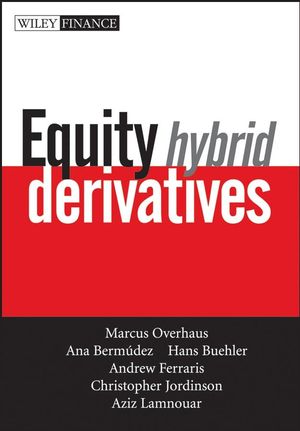Equity Hybrid DerivativesISBN: 978-0-471-77058-9
Hardcover
336 pages
February 2007
 This is a Print-on-Demand title. It will be printed specifically to fill your order. Please allow an additional 10-15 days delivery time. The book is not returnable.
|
||||||
PART ONE: Modeling Volatility.
CHAPTER 1: Theory.
1.1 Concepts of Equity Modeling.
1.1.1 The Forward.
1.1.2 The Shape of Dividends to Come.
1.1.3 European Options on the Pure Stock Process.
1.2 Implied Volatility.
1.2.1 Sticky Volatilities.
1.3 Fitting the Market.
1.3.1 Arbitrage-Free Option Price Surfaces.
1.3.2 Implied Local Volatility.
1.3.3 European Payoffs.
1.3.4 Fitting the Market with Discrete Martingales.
1.4 Theory of Replication.
1.4.1 Replication in Diffusion-Driven Markets.
CHAPTER 2: Applications.
2.1 Classic Equity Models.
2.1.1 Heston.
2.1.2 SABR.
2.1.3 Scott’s Exponential Ornstein-Uhlenbeck Model.
2.1.4 Other Stochastic Volatility Models.
2.1.5 Extensions of Heston’s Model.
2.1.6 Cliquets.
2.1.7 Forward-Skew Propagation.
2.2 Variance Swaps, Entropy Swaps, Gamma Swaps.
2.2.1 Variance Swaps.
2.2.2 Entropy Swaps.
2.2.3 Gamma Swaps.
2.3 Variance Swap Market Models.
2.3.1 Finite Dimensional Parametrizations.
2.3.2 Examples.
2.3.3 Fitting to the Market.
PART TWO: Equity Interest Rate Hybrids.
CHAPTER 3: Short-Rate Models.
3.1 Introduction.
3.2 Ornstein-Uhlenbeck Models.
3.3 Calibrating to the Yield Curve.
3.3.1 Hull-White Model.
3.3.2 Generic Ornstein-Uhlenbeck Models.
3.4 Calibrating the Volatility.
3.4.1 Hull-White/Vasicek.
3.4.2 Generic Ornstein-Uhlenbeck Models.
3.5 Pricing Hybrids.
3.5.1 Finite Differences.
3.5.2 Monte Carlo.
3.6 Appendix: Least-Squares Minimization.
3.6.1 Newton-Raphson Method.
3.6.2 Broyden’s Method.
CHAPTER 4: Hybrid Products.
4.1 The Effects of Assuming Stochastic Rates.
4.2 Conditional Trigger Swaps.
4.3 Target Redemption Notes.
4.3.1 Structure.
4.3.2 Back-Testing.
4.3.3 Valuation Approach.
4.3.4 Hedging.
4.4 Convertible Bonds.
4.4.1 Introduction.
4.4.2 The Governing Equation.
4.4.3 Detailed Specification of the Model.
4.4.4 Analytical Solutions for a Special CB.
4.5 Exchangeable Bonds.
4.5.1 The Valuation PDE.
4.5.2 Coordinate Transformations for Numerical Solution.
CHAPTER 5: Constant Proportion Portfolio Insurance.
5.1 Introduction to Portfolio Insurance.
5.2 Classical CPPI.
5.3 Restricted CPPI.
5.3.1 Constraints on the Investment Level.
5.3.2 Constraints on the Floor.
5.3.3 An Example Structure.
5.4 Options on CPPI.
5.4.1 The Pricing.
5.4.2 Delta, Gamma, and Vega Exposures.
5.4.3 Hedging.
5.5 Nonstandard CPPIs.
5.5.1 Complex Fee Structures.
5.5.2 Dynamic Gearing.
5.5.3 Perpetual CPPI.
5.5.4 Flexi-Portfolio CPPI.
5.5.5 Off-Balance-Sheet CPPI.
5.6 CPPI as an Underlying.
5.7 Other Issues Related to the CPPI.
5.7.1 Liquidity Issues (Hedge Funds).
5.7.2 Assets Suitable for CPPIs.
5.8 Appendixes.
5.8.1 Appendix A.
5.8.2 Appendix B.
5.8.3 Appendix C.
PART THREE: Equity Credit Hybrids.
CHAPTER 6: Credit Modeling.
6.1 Introduction.
6.2 Background on Credit Modeling.
6.2.1 Structural Approach.
6.2.2 Reduced-Form Approach.
6.3 Modeling Equity Credit Hybrids.
6.3.1 Dynamics of the Hazard Rate.
6.3.2 Model Choice.
6.4 Pricing.
6.4.1 Credit Default Swap.
6.4.2 Credit Default Swaption.
6.4.3 European Call.
6.5 Calibration.
6.5.1 Stripping of Hazard Rate.
6.5.2 Calibration of the Hazard Rate Process.
6.5.3 Calibration of the Equity Volatility.
6.5.4 Discussion.
6.6 Introduction of Discontinuities.
6.6.1 The New Framework.
6.6.2 Dynamics of the Survival Probability.
6.6.3 Pricing of European Options.
6.6.4 Fourier Pricing.
6.7 Equity Default Swaps.
6.7.1 Modeling Equity Default Swaps.
6.7.2 Single-Name EDSs in a Deterministic Hazard Rate Model.
6.8 Conclusion.
PART FOUR: Advanced Pricing Techniques.
CHAPTER 7: Copulas Applied to Derivatives Pricing.
7.1 Introduction.
7.2 Theoretical Background of Copulas.
7.2.1 Definitions.
7.2.2 Measures of Dependence.
7.2.3 Copulas and Stochastic Processes.
7.2.4 Some Popular Copulas.
7.3 Factor Copula Framework.
7.4 Applications to Derivatives Pricing.
7.4.1 Equity Derivatives: The Altiplano.
7.4.2 Credit Derivatives: Basket and Tranche Pricing.
7.5 Conclusion.
CHAPTER 8: Forward PDEs and Local Volatility Calibration.
8.1 Introduction.
8.1.1 Local and Implied Volatilities.
8.1.2 Dupire’s Formula and Its Problems.
8.1.3 Dupire-like Formula in Multifactor Models.
8.2 Forward PDEs.
8.3 Pure Equity Case.
8.4 Local Volatility with Stochastic Interest Rates.
8.5 Calibrating the Local Volatility.
8.6 Special Case: Vasicek Plus a Term Structure of Equity Volatilities.
CHAPTER 9: Numerical Solution of Multifactor Pricing Problems Using Lagrange-Galerkin with Duality Methods.
9.1 Introduction.
9.2 The Modeling Framework: A General D-factor Model.
9.2.1 Strong Formulation of the Linear Problem: Partial Differential Equations.
9.2.2 Truncation of the Domain and Boundary Conditions.
9.2.3 Strong Formulation of the Nonlinear Problem: Partial Differential Inequalities.
9.2.4 Weak Formulation of the Nonlinear Problem: Variational Inequalities.
9.3 Numerical Solution of Partial Differential Inequalities (Variational Inequalities).
9.3.1 A Duality (or Lagrange Multiplier) Method.
9.4 Numerical Solution of Partial Differential Equations (Variational Equalities): Classical Lagrange-Galerkin Method.
9.4.1 Semi-Lagrangian Time Discretization: Method of Characteristics.
9.4.2 Space Discretization: Galerkin Finite Element Method.
9.4.3 Order of Classical Lagrange-Galerkin Method.
9.5 Higher-Order Lagrange-Galerkin Methods.
9.5.1 Crank-Nicolson Characteristics/Finite Elements.
9.6 Application to Pricing of Convertible Bonds.
9.6.1 Numerical Solution.
9.6.2 Numerical Results.
9.7 Appendix: Lagrange Triangular Finite Elements.
9.7.1 Lagrange Triangular Finite Elements.
9.7.2 Coefficients Matrix and Independent Term in Two Dimensions.
CHAPTER 10: American Monte Carlo.
10.1 Introduction.
10.2 Broadie and Glasserman.
10.3 Regularly Spaced Restarts.
10.4 The Longstaff and Schwartz Algorithm.
10.4.1 The Algorithm.
10.4.2 Example: A Call Option with Monthly Bermudan Exercise.
10.5 Accuracy and Bias.
10.5.1 Extension: Regressing on In-the-Money Paths.
10.5.2 Linear Regression.
10.5.3 Other Regression Schemes.
10.5.4 Upper Bounds.
10.6 Parameterizing the Exercise Boundary.
Bibliography.
Index.



